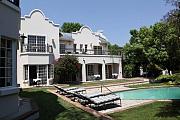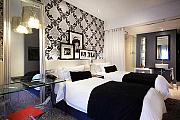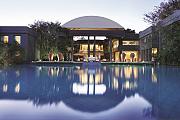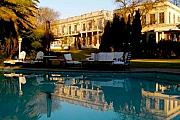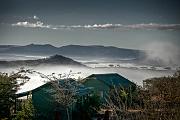Discover Johannesburg
Many people skip a visit to Johannesburg en-route to the Kruger National Park, Madikwe or Kwa-Zulu Natal. A visit to Johannesburg however can be essential in understanding South Africa’s political history and it’s modern day situation.
There are also plenty of sights to keep the interest going, as well as a thriving cultural scene.
Johannesburg is a city of stark contrasts, with the vast and luxurious stately homes and villas of Gauteng district almost a stone’s throw away from the urban decay and blight of Hillbrow and much of the CBD.
The central district of Johannesburg has seen a transformation from business centre to an essentially residential area interspersed with University buildings, a few historic buildings, the occasional business headquarters and a few museum attractions.
Constitution Hill
The Old Fort dates back to 1892 and sits on a hilltop right in the heart of Johannesburg. It was originally built as a jail for British soldiers, but also ‘hosted’ various political activists including Nelson Mandela.
Ghandi was also jailed here for a short period and there is a great little exhibition in his former cell.
A short video presentation in one of the former cells is a great introduction and sets the context for the fort, the prison and the neighbouring Constitutional Court as well as the Apartheid system.
The Constitutional Court is a modern building with a great design, built partly from the reconstructed remains of the old prison. The court is highly symbolic for the new South Africa.
Hillbrow
Constitution Hill overlooks Hillbrow, a district of Johannesburg, which was traditionally a mixed area where blacks and whites mingled and where opposition to the Apartheid system was strong.
These days the area is blighted by poor accommodation, unemployment and homelessness. City tours of Johannesburg usually include a drive through Hillbrow as an essential part of understanding the city.
The CBD
The CBD of Johannesburg is the opposite of many world cities central business districts, since the abandonment of the CBD by many businesses in the 1990’s.
Street life is vibrant, hawkers line the streets, traditional African healers set up little street side pharmacies and the sights, sounds and aromas keep all the senses alert.
The abandoned tower of the Carlton Hotel is symbolic of the city centre’s transformation from business to residential district. Take the elevator to the 50th floor of the Carlton Centre for the Top of Africa, a fabulous panoramic view over the city.
Other highlights of the City Centre include the Mandela & Tambo Law Offices, colonial buildings such as City Hall and the Standard Bank Art Gallery.
Newtown
Newtown is a smarter area than the CBD and has some smart cafes around Mary Fitzgerald Square. Impressive graffiti murals grace many walls lending the area a taste of certain areas of New York or East London. The Museum of Africa in the Bree Street Fruit Market is well worth a visit.
Spanning the railway tracks the Nelson Mandela Bridge is symbolic of the rejuvenation of this part of Johannesburg and is brightly illuminated at night.
Close to the bridge, beer lovers will be enticed by the SAB World of Beer, a highly enjoyable tour through the history of beer.
Apartheid Museum
Located in the southern suburbs of Johannesburg, the Apartheid Museum is one of the best attractions in Johannesburg.
On arrival, visitors are presented with a card stating their race and must enter the Museum by the stipulated racial entrance.
A visit to the Apartheid Museum is really essential for anyone looking to gain a deeper understanding of the Apartheid system.
Soweto
A visit to Soweto (an acronym for South Western Townships) is an eye-opening experience and essential to really experience and understand Johannesburg as well as recent South African history.
Soweto is a sprawling township in the southern outskirts of Johannesburg, home to over 2 million residents who reside in accommodation ranging from century-old former mineworkers hostels and tin shacks with no facilities, through to rather swish houses in the ‘Beverley Hills’ area of Soweto.
Winnie Mandela’s house is still here and one of the highlights of a visit to Soweto is Nelson Mandela’s former house in Soweto, a modest ‘matchbox’ house he shared with his first wife Evelyn and later with Winnie, now filled with relics and memorabilia.
South African police besieged the house on several occasions and bullet holes still pockmark the walls.
Desmond Tutu’s house is just down the street (Vilakezi Street), meaning there are two Nobel Peace Prize winners’ houses within a couple of hundred yards of each other.
The Soweto student uprising of 1976 is commemorated in the excellent Hector Pieterson Museum which is both moving and informative in it’s recounting of the Soweto student uprising, where hundreds of children were shot dead by South African Security Forces in the face of peaceful protests against the introduction of Afrikaans into school curricula.
Drive past the FNB Stadium (formerly Soccer City), where the 2008 World Cup Final was staged. Also close by is the Orlando Stadium, setting for the Soweto derby, where Orlando Pirates take on their Sowetan rivals the Kaiser Chiefs.
The highlight of a visit to Johannesburg is the remarkable Apartheid Museum, which is in the southern suburbs of Johannesburg and usually included on a day tour to Soweto.
This superbly presented museum traces the origins of the Apartheid system through to the dismantling of Apartheid and post-Apartheid South Africa.
The exhibits and descriptions are compelling and many visitors find themselves spending longer here than expected.
A semi-permanent Nelson Mandela exhibition provides a powerful and insightful telling of his life and achievements in an engaging way.



